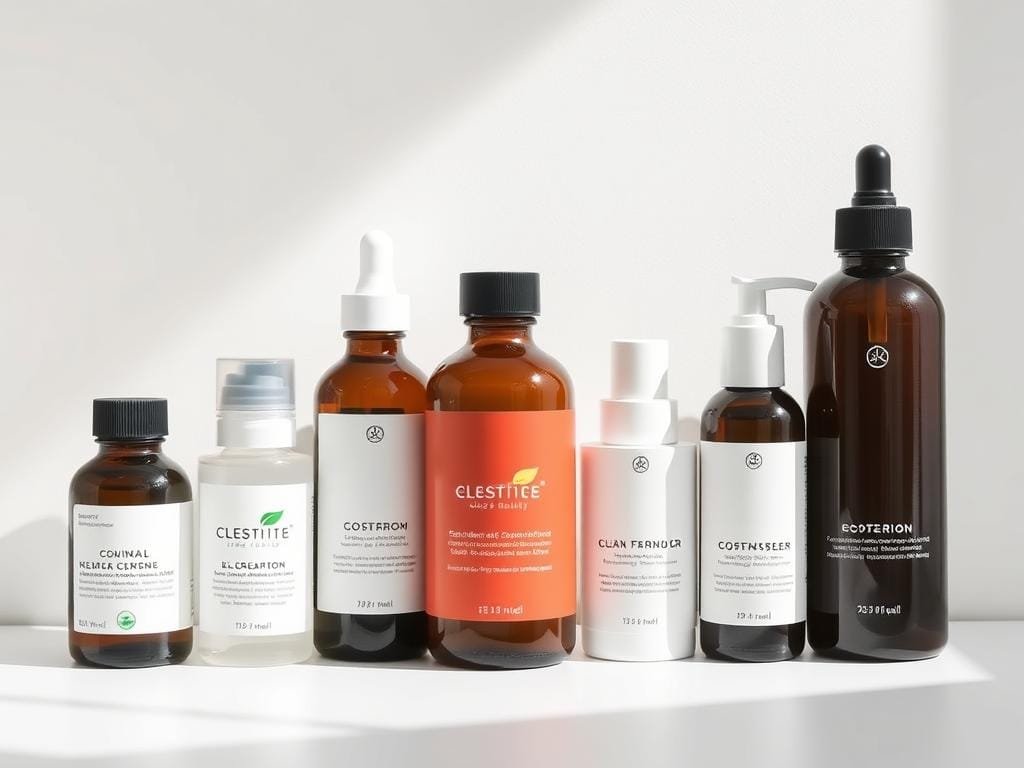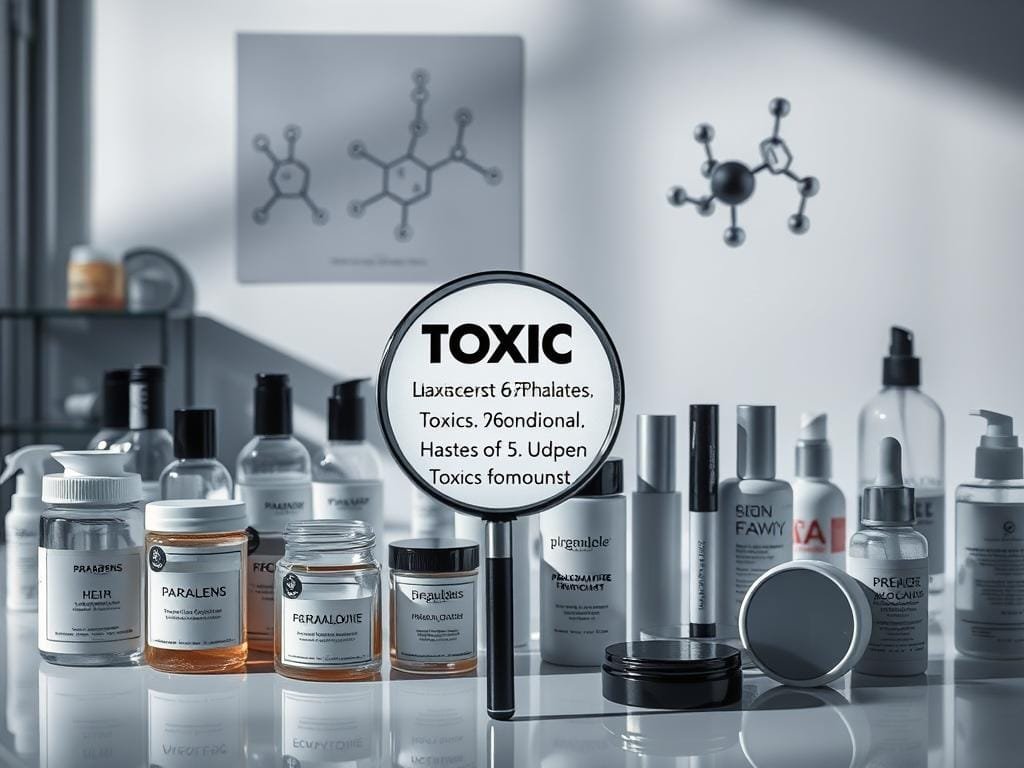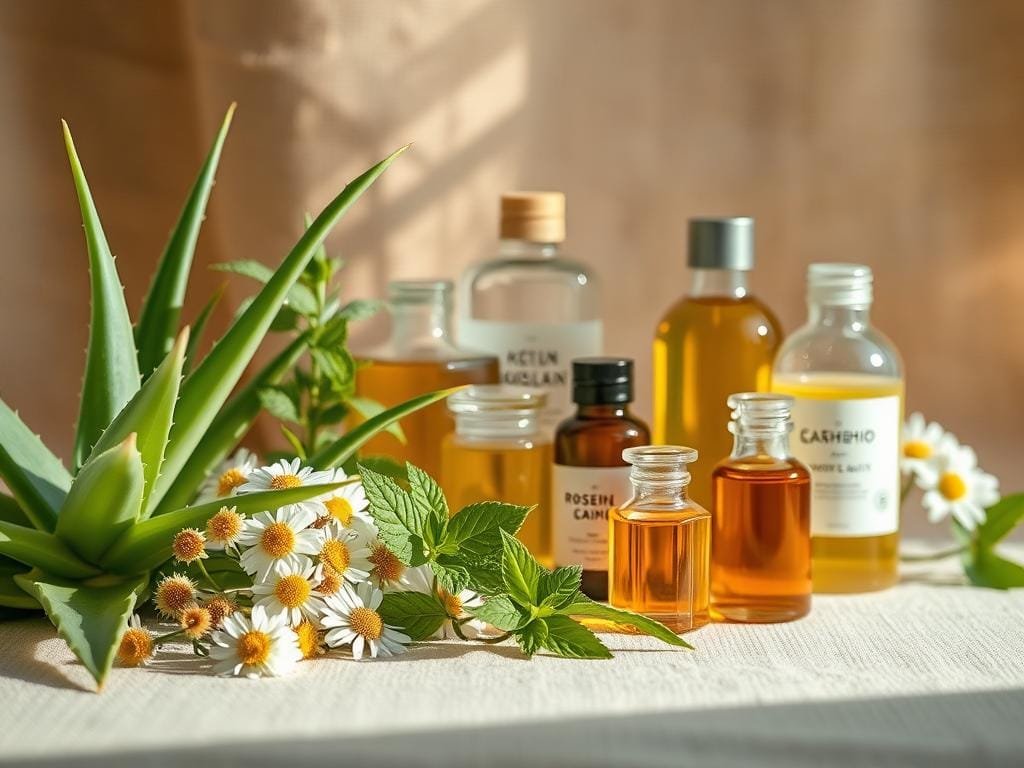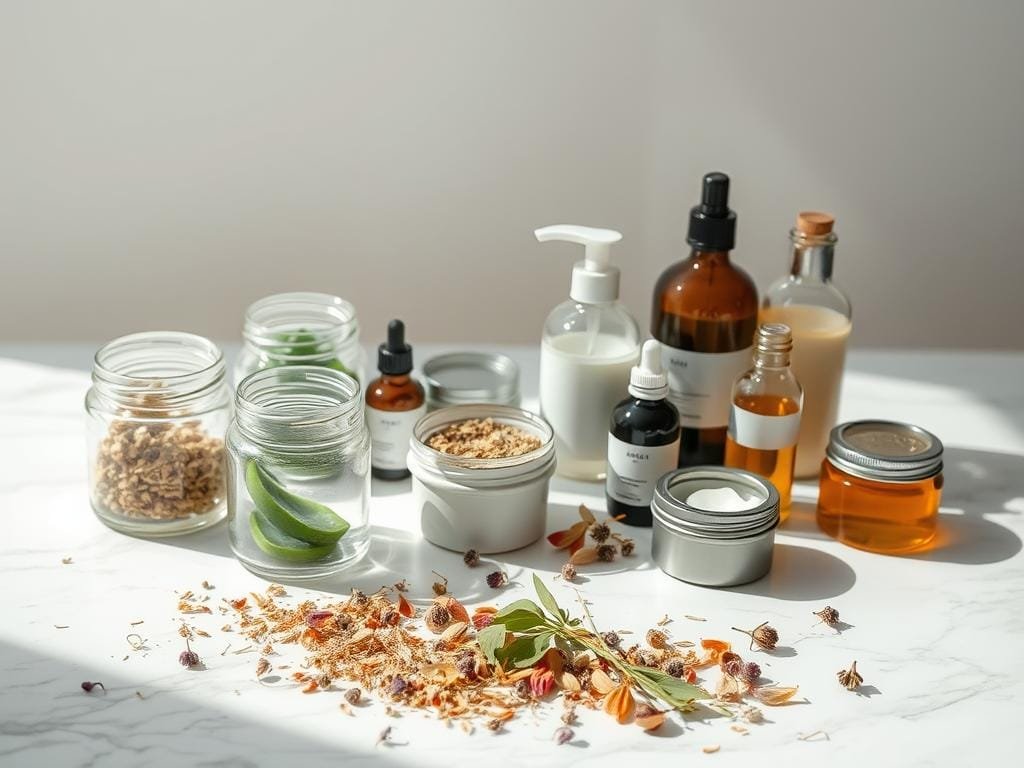Many personal care products contain harmful ingredients. This is alarming news for your health and the environment. The clean beauty movement is growing, as more people choose what they put on their skin.
Some beauty products have toxic chemicals. These can irritate your skin, upset your hormones, and even affect your reproductive health. Switching to a non-toxic skincare routine can protect your skin and health.
To make smart choices, it’s key to understand what’s in your beauty products. Opting for natural skincare can lead to a healthier, brighter complexion.
Table of Contents
Key Takeaways
- Understand the importance of clean beauty and its impact on your health.
- Learn how to identify toxic chemicals in beauty products.
- Discover the benefits of adopting a non-toxic skincare routine.
- Explore natural ingredients that promote healthy, glowing skin.
- Make informed choices when selecting eco-friendly beauty products.
The Rise of Clean Beauty Movement
In recent years, the clean beauty movement has become a big trend. It’s all about safer, more sustainable beauty products. As you learn more about your beauty products, you’ll see a move towards cleaner options.
What Defines “Clean Beauty”
Clean beauty means products that are good for your skin and the planet. Clean beauty products use natural, non-toxic ingredients and have eco-friendly packaging. Brands that follow clean beauty are open about their ingredients and how they make their products.
When looking for clean beauty products, you might see “Cruelty-Free” or “Vegan” labels. These show the products haven’t been tested on animals and don’t have animal products. While these aren’t the only signs of clean beauty, they show a brand cares about ethics and the environment.
Why More Consumers Are Making the Switch
So, why are people choosing clean beauty? There are many reasons. Some worry about the health effects of synthetic chemicals in regular beauty products. Others care about the environment, like pollution from microplastics and packaging waste.
Exploring clean beauty, you’ll find these products are good for your skin and work well. Natural ingredients like plant extracts and essential oils offer remarkable benefits. They can soothe skin and help with healthy aging.
The Environmental and Health Benefits
Clean beauty is great for the environment. Choosing products with eco-friendly packaging and sustainable ingredients helps the beauty industry be more responsible. This can reduce waste and save natural resources.
From a health standpoint, clean beauty is a big change. It avoids harsh chemicals and toxins, which can irritate or cause allergies. This is key for people with sensitive skin or allergies. Choosing clean beauty helps protect your health and well-being.
Understanding Product Labels: Your First Step to Clean Beauty
To make informed choices in clean beauty, you need to decode product labels effectively. Knowing what’s in your beauty products is key for a toxin-free routine.
Deciphering Ingredient Lists
The ingredient list on your beauty products can be overwhelming. But it’s full of useful information. Ingredients are listed in order of concentration, so the first few are the main ingredients. Look out for harmful chemicals like parabens and sulfates, which are often used.
For example, in a cleanser, you might see water or aqua first, followed by a cleansing agent like sodium lauryl sulfate. Knowing these ingredients helps you make better choices.

Common Certification Symbols and What They Mean
Certification symbols can make shopping easier by showing that a product meets standards. For instance, the Leaping Bunny logo means the product is cruelty-free. The USDA Organic seal means it has a lot of organic ingredients.
| Certification Symbol | Meaning |
|---|---|
| Leaping Bunny | Cruelty-free |
| USDA Organic | Contains organic ingredients |
| ECOCERT | Meets environmental and social standards |
The Truth Behind “Natural” and “Organic” Claims
The terms “natural” and “organic” are often used loosely in beauty. “Natural” means the product comes from natural sources, but it’s not always safe or effective. “Organic” means the ingredients are grown without synthetic fertilizers or pesticides.
It’s important to remember that rules around these terms vary. So, it’s key to look beyond the label and check the ingredient list and certifications.
Toxic Ingredients to Eliminate From Your Beauty Routine
The clean beauty movement is about what you add and what you remove. It’s about avoiding toxic ingredients in your products. These ingredients can harm your health and the environment. It’s important to know which ones to avoid for a clean beauty routine.

Harmful Preservatives: Parabens and Formaldehyde
Parabens and formaldehyde are used to keep products fresh longer. But, they can cause health problems. Parabens mess with hormones, and formaldehyde can cause cancer. Look for products with natural preservatives instead.
- Be cautious of products listing “paraben” or “formaldehyde” on the label.
- Opt for products labeled “paraben-free” or “formaldehyde-free.”
- Consider products that use natural preservatives like vitamin E or plant extracts.
Synthetic Fragrances and Phthalates
Synthetic fragrances often include phthalates, which can harm your health. The term “fragrance” can mean many chemicals. Choose products with natural fragrances or those labeled “phthalate-free” to avoid exposure.
For more information on contaminants in cosmetics, visit the Environmental Working Group’s guide on the toxic twelve chemicals and contaminants in.
Sulfates, Silicones, and Petroleum Derivatives
Sulfates, silicones, and petroleum derivatives can be harmful. Sulfates dry out your skin. Silicones can clog pores. Petroleum derivatives can cause blackheads and more serious skin problems.
To avoid these ingredients:
- Check the ingredient list for sulfates (e.g., sodium lauryl sulfate).
- Opt for silicone-free products to avoid pore clogging.
- Choose products that use natural oils instead of petroleum derivatives.
By avoiding these toxic ingredients, you can reduce harmful chemical exposure. This leads to a cleaner, healthier beauty routine.
Clean Beauty Heroes: Beneficial Ingredients to Embrace
The clean beauty movement is more than avoiding toxins. It’s about using ingredients that really help your skin. You’ll find many nourishing ingredients in clean beauty products that can make your skincare routine better.
Plant-Based Oils and Butters
Plant-based oils and butters are key in clean beauty. They deeply hydrate and nourish your skin. Here are some top plant-based oils:
- Coconut Oil: It’s great for moisturizing and soothing dry skin.
- Argan Oil: It’s full of antioxidants that reduce fine lines and wrinkles.
- Jojoba Oil: It’s absorbed easily and keeps your skin’s moisture balanced.
Butters like shea and mango butter deeply moisturize and calm irritated skin.

Natural Antioxidants and Vitamins
Natural antioxidants and vitamins protect your skin from harm and keep it looking young. Key ingredients include:
- Vitamin C: It brightens your skin and boosts collagen.
- Vitamin E: It protects your skin from free radicals.
- Green Tea Extract: It’s full of antioxidants that soothe and calm your skin.
Mineral-Based Sunscreens and Pigments
Mineral-based sunscreens protect your skin from UV rays without harsh chemicals. Zinc oxide and titanium dioxide create a barrier. Mineral pigments also give natural color to makeup without synthetic dyes.
Benefits of mineral-based sunscreens include:
- Immediate Protection: They work right away.
- Non-Irritating: Good for sensitive skin.
- Environmentally Friendly: Many are reef-safe.
Using these ingredients helps you avoid toxins and nourish your skin.
The Clean Beauty Approach to Korean Skincare
The clean beauty movement is growing fast, and Korean skincare is leading the way. It offers new, chemical-free solutions. Now, you can get that “glass skin” look without using harsh chemicals.
Clean Alternatives to K-Beauty Staples
Many K-beauty products don’t fit the clean beauty bill. But, there are now clean alternatives that work just as well. For example, you can swap out harsh cleansers for gentle, sulfate-free ones.
Some brands are making clean versions of K-beauty favorites like sheet masks and essences. They use natural ingredients and avoid harsh chemicals. So, you can enjoy K-beauty without giving up on clean beauty.
Achieving “Glass Skin” Without Toxins
“Glass skin” is all about having a smooth, bright complexion. You can get this look without toxins. Use products with natural antioxidants, hyaluronic acid, and plant extracts.
To get “glass skin,” keep your skincare routine simple and consistent. Use gentle cleansers, hydrate well, and protect your skin from the sun. Choose clean beauty products that nourish and protect your skin.
Korean Botanical Ingredients Making Waves in Clean Beauty
Korean skincare is known for its natural ingredients. These botanicals are now in clean beauty products. Ginseng, green tea, and snail mucin are popular for their skin benefits, like anti-aging and hydration.
| Botanical Ingredient | Benefits | Clean Beauty Products |
|---|---|---|
| Ginseng | Anti-aging, brightening | Serums, essences |
| Green Tea | Antioxidant, soothing | Toners, sheet masks |
| Snail Mucin | Hydrating, regenerative | Moisturizers, creams |
By using natural ingredients and clean beauty, you can enjoy Korean skincare without toxins.
Building Your Clean Beauty Routine: Product by Product
A clean beauty routine starts with the basics like cleansers and toners. You need to pick products with safe, natural ingredients. For more tips, check out Oprah Daily’s article on clean beauty routines.
Cleansers and Toners
Start with cleansers and toners, key parts of any skincare routine. Look for cleansers without harsh sulfates. Instead, choose gentle ingredients like coconut oil or aloe vera. Toners should be alcohol-free and have soothing botanicals.
- Choose a gentle, oil-based cleanser for makeup and impurities.
- Then, use a toner that balances your skin’s pH and gets it ready for more products.

Serums and Moisturizers
Serums and moisturizers are vital for tackling skin issues and keeping it hydrated. Serums should have natural antioxidants like vitamin C or plant extracts. Moisturizers should be rich in emollients and humectants, like shea butter or hyaluronic acid.
- Pick a serum for your specific skin concerns, like dark spots or fine lines.
- Finish with a moisturizer that keeps hydration in and supports the skin’s barrier.
Makeup and Color Cosmetics
For makeup and color cosmetics, choose products with natural pigments and few synthetic additives. Foundations and concealers should be labeled as “non-comedogenic” or “hypoallergenic” to avoid skin irritation.
- Go for mineral-based makeup without talc and other harmful ingredients.
- Look for brands that offer clean, cruelty-free makeup alternatives.
Hair Care and Body Products
Remember hair care and body products in your clean beauty routine. For hair, pick shampoos and conditioners without sulfates and with nourishing ingredients. For body care, choose products without synthetic fragrances and dyes.
- Use a gentle, sulfate-free shampoo that cleanses without drying out your hair.
- For body washes and lotions, pick products with natural fragrances and moisturizers.
Transitioning to Clean Beauty Without Breaking the Bank
Switching to clean beauty doesn’t have to cost a lot. You can start by making small changes and choosing the right products. This way, you can enjoy a cleaner beauty routine without spending too much.
Gradual Replacement Strategy
One smart way to go clean is to replace products slowly. When you finish a product, like a moisturizer, switch to a cleaner version. For more tips on making the switch, check out our guide: How to Transition to a Clean Beauty.
- Identify your most used products.
- Swap out harsh chemicals for cleaner options.
- Slowly get rid of products with toxic ingredients.
Multi-Purpose Products Worth Investing In
Buying multi-purpose products is another budget-friendly tip. These items can make your routine simpler and cut down on the number of products you buy.
| Product | Benefits | Clean Beauty Brands |
|---|---|---|
| Coconut Oil | Moisturizes, nourishes, and can be used as a makeup remover | Dr. Bronner’s, Coconut Oil by Nutiva |
| Aloe Vera Gel | Soothes, hydrates, and can be used as a face mask or after-sun care | Lily of the Desert, Aloe vera gel by Nature Republic |
| Jojoba Oil | Balances skin’s natural pH, moisturizes, and can be used as a hair serum | Simmonds Botanicals, Jojoba Oil by The Ordinary |
Budget-Friendly Clean Beauty Brands
Many clean beauty brands offer affordable options without sacrificing quality or safety. Some great brands include:
- Alba Botanica: Known for their natural and organic products.
- Acure: Offers a range of argan oil-based products that are affordable and effective.
- SheaMoisture: Provides natural and organic products for hair and skin care.
By slowly replacing products, choosing multi-purpose items, and picking affordable brands, you can easily switch to clean beauty without spending a lot.
Navigating Common Clean Beauty Myths and Misconceptions
Exploring clean beauty means knowing what’s real and what’s not. The clean beauty movement has sparked many debates. But, it’s also led to some wrong ideas about its safety and effectiveness.
For more insights on debunking common myths about clean beauty, visit True Glue’s blog for a deeper dive into the topic.
Clean Products Don’t Work as Well
Many think clean beauty products are less effective than others. But, many clean beauty brands have made safe and effective products. For example, natural antioxidants like vitamin C are great for your skin.
Natural ingredients can be as powerful as synthetic ones. It’s all about knowing the ingredients and their amounts. Clean beauty uses botanicals and natural extracts to achieve results without harsh chemicals.
Natural Ingredients Can’t Cause Reactions
Some believe natural ingredients are always safe and won’t cause reactions. But, natural ingredients can cause allergic reactions or irritations in some people. For instance, certain essential oils can irritate sensitive skin.
Always patch test new products, even if they’re labeled as “natural” or “clean.” Your skin’s reaction can differ based on its unique needs and sensitivities.
All Synthetic Ingredients Are Harmful
The idea that all synthetic ingredients are bad is a myth. While some synthetics have health concerns, not all are harmful. Some are made to improve the stability and effectiveness of clean beauty products.
Understanding the specific ingredient and its role in the product is key. Being informed helps you choose products that fit your clean beauty standards.
By knowing the truth about common clean beauty myths, you can make better choices for your skincare. This way, you can enjoy the benefits of clean beauty.
Conclusion: Embracing Your Personal Clean Beauty Journey
Starting a clean beauty journey is a personal choice. It’s about picking products that are good for your skin. You’ve learned that it’s not just about avoiding bad stuff. It’s also about using natural and safe cosmetics.
Understanding what’s in your products is key. Say no to harmful ingredients and yes to good ones. This way, you can make a beauty routine that’s right for you. It’s about feeling good in your own skin, whether you want “glass skin” or just to feel confident.
Every little step you take matters. Choosing products that are good for the planet helps your skin and the environment. You’re making a positive change in the beauty world.
